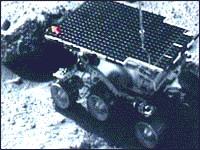 But, they do have a view of the Martian surface from a standing position.
But, they do have a view of the Martian surface from a standing position.
"We now have the ability to look at our landing site from a standing position," says Peter Smith, principal investigator of Pathfinder's imager, dubbed IMP (Imager for Mars Pathfinder).
Standing view of landing site, with Pathfinder's airbags. Click on image above for a pan of the landing site from a standing position if you have a 28.8 connection.
Standing view of Yogi among other rocks, which appeared much larger from the ground.
Sojourner checking out Barnacle Bill.
The first rock to be analyzed is Barnacle Bill, named after its barnacle-like structures on its surface. Sojourner's
spectrometer was already locked onto Bill late Sunday night. Both the analysis of the Martian soil and of Barnacle Bill
will be presented tomorrow.
 IMP was raised on its mast, and the view from above showed the large boulders that formed much of the Martian horizon were much smaller than thought.
"[They] now seem small and as we look over them and we realize they're one to two feet high, we have a new perspective," says Smith.
IMP was raised on its mast, and the view from above showed the large boulders that formed much of the Martian horizon were much smaller than thought.
"[They] now seem small and as we look over them and we realize they're one to two feet high, we have a new perspective," says Smith.
 The scientists were excited about the diversity in the rocks, naming them in an ad hoc fashion that are "sort of fun,
" says project scientist Matthew Golombek, with bags under his eyes. A name "czar" screens the names the scientists give them.
The scientists were excited about the diversity in the rocks, naming them in an ad hoc fashion that are "sort of fun,
" says project scientist Matthew Golombek, with bags under his eyes. A name "czar" screens the names the scientists give them.
The team's scientists also relayed that everything was working perfectly, including the lander, rover, IMP and the
weather station. It was all a matter of time and much needed sleep before they could present the data to the public.
 Happy but tired, Carl Sagan Memorial Station's team of scientists couldn't deliver on yesterday's promise for a colour panoramic view of the landing site. (The Mars Pathfinder was renamed Saturday by NASA to honour Dr. Carl Sagan, an astrophysicist who popularized planetary exploration.)
Nor were they able to analyze the data from Sojourner's alpha proton x-ray spectrometer which was set against the Martian soil overnight Saturday for ten hours of measurements, soon after communication resumed between Sojourner and the lander. The spectrometer can analyze the elemental composition of whatever it's put up against. But, time and a harmless buzz from the data prevented the scientists from analyzing the data they received.
Happy but tired, Carl Sagan Memorial Station's team of scientists couldn't deliver on yesterday's promise for a colour panoramic view of the landing site. (The Mars Pathfinder was renamed Saturday by NASA to honour Dr. Carl Sagan, an astrophysicist who popularized planetary exploration.)
Nor were they able to analyze the data from Sojourner's alpha proton x-ray spectrometer which was set against the Martian soil overnight Saturday for ten hours of measurements, soon after communication resumed between Sojourner and the lander. The spectrometer can analyze the elemental composition of whatever it's put up against. But, time and a harmless buzz from the data prevented the scientists from analyzing the data they received.
